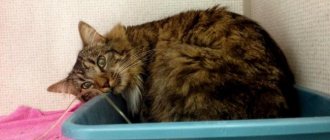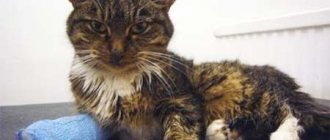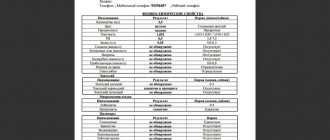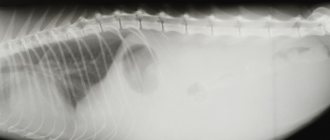Kidney diseases in cats are serious and dangerous pathologies that can lead to the death of the animal. They cause destruction of organ tissue, causing it to cease to perform its functions. The kidneys lose their ability to remove toxins from the blood, secrete urine, and maintain water-salt and acid balance. If you do not notice and ignore the signs of kidney disease in cats, the development of chronic renal failure (CRF), disability and death of the animal is possible.
Kidney structure
The kidneys are a paired oval (bean-shaped in dogs) organ, which in cats is located in the abdominal cavity, in the center of the back (at the level of 7-8 ribs), on both sides of the spine. In this case, the left half may have greater mobility.
The kidneys are made up of nephrons, each of which contains a glomerulus (a collection of capillaries) and a system of tubules. Each nephron is reliably protected from damage by a capsule.
Externally the kidneys look like this:
- The organ is protected from damage by a fibrous capsule, which in turn is located in a fatty capsule, whose thickness depends on the weight of the animal.
- The portal includes the renal artery, through which blood enters the kidneys for purification.
- The renal vein, ureter, and lymphatic vessels emerge from the organ.
- The ureter begins in the renal pelvis and discharges the resulting urine into the bladder.
Diagnostic tests
To accurately determine whether a cat has kidney failure, your veterinarian will need to do a series of diagnostic tests, which include:
- Ultrasound of the kidneys;
- X-ray with contrast agent;
- computed tomography of affected organs.
Note! Kidney CT is the most informative, but at the same time expensive examination. Therefore, it is used only in large clinics where there is appropriate equipment.
The final diagnosis is made on the basis of anamnestic data, ultrasound (radiography) results, laboratory tests of the animal’s blood and urine.
Kidney functions
The main job of the kidneys is to remove toxins from the body. It also forms urine, which contains:
- excess liquids, mineral salts, organic substances;
- uric acid;
- urea;
- ammonia, other metabolic products.
Urine flows down the ureters into the bladder, then comes out during emptying.
Other features
- Maintaining water, electrolyte, acid-base balance;
- regulation of blood pressure;
- removal of excess calcium;
- production of the active form of hormone D;
- synthesis of the hormone erythropoietin, which is responsible for the creation of red blood cells in the bone marrow.
Common kidney pathologies in cats
If the kidneys do not work properly, the body begins to malfunction, which can lead to serious problems. The most dangerous lesion is acute or chronic renal failure, untimely treatment of which leads to death. The acute form occurs quickly and is usually a consequence of poisoning.
Chronic kidney disease in cats takes a long time to develop, so it occurs mainly in older animals. It is usually a complication of other diseases of this organ:
- Pyelonephritis is an inflammation of the kidneys caused by bacteria, usually a consequence of cystitis (inflammation of the bladder).
- Polycystic disease is a congenital pathology, often found in pets with long hair.
- Poisoning. Causes include poisonous plants (lilies), pesticides, cleaning products, human medications harmful to animals (ibuprofen, vitamin D).
- Stones in the kidneys or urinary tract that interfere with the flow of urine from the organ.
- Glomerulonephritis – damage to the glomeruli.
- Neoplasia is a tumor, the most common is lymphosarcoma.
- Amyloidosis is an accumulation of protein in an organ that impairs its function.
Causes of kidney disease in cats
Problems can be caused by both primary and secondary causes:
- Genetic factor - Abyssinian cats and Persians are predisposed to kidney disease.
- Viral infections – feline leukemia (FeLV) or feline infectious peritonitis (FIP).
- Heart failure, which is accompanied by low blood pressure, which reduces blood flow to the organ.
- Trauma associated with a pelvic fracture or bladder rupture.
- Bacterial infections, due to which pathogens were able to get close to the kidneys - chronic periodontal disease, inflammation of the uterus, pancreatitis, endocarditis.
- Worms.
- Autoimmune diseases – lupus erythematosus.
Symptoms of kidney disease in cats
Early signs of kidney disease in cats can indicate any other pathology - lethargy, apathy, dull hair, and sometimes baldness. One of the first obvious symptoms of kidney disease in cats is frequent or infrequent urination. In the first case, the urinary system does not retain fluid well. In the second, problems with the formation of urine or stones (tumor) block its outflow.
Other symptoms of kidney disease in cats that indicate the need for treatment include:
- painful urination;
- involuntary emptying outside the tray;
- strong thirst;
- loss of appetite, weight loss;
- mouth ulcers;
- brown tongue
In later stages appears:
- vomiting, diarrhea or constipation, bloody or cloudy urine;
- unpleasant odor of ammonia from the mouth.
Diagnosis of kidney problems in cats
Kidney disease in cats is usually diagnosed based on blood tests for urea and creatinine levels. These protein breakdown products can only be excreted from the body through urine. Therefore, their increased amount in the blood indicates problems with the kidneys. The degree of damage is determined by the number of creatinine, since an increase in urea does not always correspond to the severity of the pathology.
To determine pyelonephritis and other diseases, you need to do a pet urine test for the presence of albumin in the blood. The more protein in the urine, the worse the situation. To diagnose pyelonephritis and other pathologies, it is necessary to do an ultrasound, x-ray, and biopsy.
Until recently, early diagnosis of chronic renal failure was a difficult task. For an accurate diagnosis there were few clinical symptoms, increased levels of nitrogen, urea, and creatinine in the blood. By their level, it was possible to determine CKD only when the organ almost completely failed.
Now there is a blood test SDMA (SDMA), which allows you to determine the loss of kidney function by 25%. Its level rises long before the rise in creatinine in the blood. Even if the kidneys of cats and dogs are slightly damaged, the test can determine the presence of diseases that adversely affect the organ.
Stages of chronic renal failure according to IRIS
- stage: creatinine less than 140 mmol/l, SDMA less than 14, blood pressure less than 150/95 mmHg.
- stage: creatinine 140-249 mmol/l, SDMA 14-25, blood pressure 150-159/95-99 mmHg.
- stage: creatinine 250-439 mmol/l, SDMA above 25, blood pressure 160-179/100/119 mmHg.
- stage: creatinine more than 440 mmol/l, SDMA above 45, blood pressure above 180/120 mmHg.
Determination of the stage and prognosis of the disease is carried out only in a stable patient.
Substages of chronic renal failure:
- Non-proteinuric less than 0.2 protein
- Borderline proteinuric 0.2–0.4 protein
- Proteinuric more than 0.4 protein
Treatment of kidney disease in cats
When treating kidney disease, the veterinarian will pay attention to the level of electrolytes in the blood. You may need to take the following medications:
- Medicines for phosphorus binding are prescribed if the analysis shows their elevated levels in the blood. Reducing phosphorus improves the pet’s well-being and slows down the progression of the disease.
- Potassium supplements. Animals with renal pathology often lose potassium in the urine, which leads to muscle weakness, deterioration of coat condition, and chronic renal failure.
- Vitamins B and C. When the organ stops concentrating urine, they dissolve in urine and are excreted from the body. Therefore, pets need daily supplements.
- Antiemetics are prescribed for the treatment of animals that suffer from disorders of the digestive system.
- Medicines to lower blood pressure. Many pets with kidney failure have elevated blood pressure, which leads to organ destruction.
- Medicines to treat anemia. The kidneys stimulate the synthesis of red blood cells in the bone marrow. When an organ is destroyed, the level of red blood cells drops. This leads to oxygen starvation and disruption of oxidative processes. Treatment with special drugs is aimed at restoring the level of red blood cells in the blood.
- Feed additives that support kidney function - Renal paste, Renaletten.
Symptoms of disorders
Characteristic signs appear only when more than 70% of tissues are affected. Most often, the disease is diagnosed in animals older than 8 years. Because of this, the first non-obvious symptoms (loss of activity and appetite) are attributed to old age. As the patient’s condition worsens, the symptoms are supplemented by:
- the appearance of an ammonia odor from the mouth and drooling;
- blanching of mucous membranes;
- increased thirst and increased frequency of urination up to 10 times a day (the norm for healthy pets is no more than 3 times);
- periodic temperature fluctuations up or down from normal;
- swelling of the paws, chest and abdomen.
Lack of appetite leads to sudden weight loss. The cat's fur becomes dull and his belly sinks. The ribs become visible to the naked eye. Due to frequent trips to the toilet, the hair on the perineum does not have time to dry. The pet constantly licks itself to get rid of droplets of urine.
With more serious violations, new signs appear:
- unsuccessful visit to the tray;
- alternating diarrhea and constipation interspersed with blood in the stool;
- frequent bloody vomiting;
- severe dehydration, expressed in dry mucous membranes;
- increased blood pressure, which threatens blindness due to rupture of blood vessels in the eyeballs;
- isolated muscle twitching and epileptic seizures.
If you notice any of these symptoms, contact your veterinarian immediately. The later the diagnosis is made, the less chance of a favorable prognosis. If the organ fails completely, the animal falls into a coma and dies.
Diet for cats with kidney disease
When the kidneys are sick, the pet suffers from dehydration. During treatment, be sure to provide him with water - give him wet food, low-sodium broth, tuna juice.
Particular attention should be paid to a diet low in protein and phosphorus. Ask your veterinarian how to feed your pet correctly. The diet should contain a reduced amount of phosphorus and protein, enriched with omega-3 fatty acids.
If you give dry cat food, it is not advisable if you have kidney disease. Give preference to high quality wet food. For example, Dr. has proven himself well. Clauder's Diet Kidney diet for kidney disease. If your pet has stones, for treatment, buy food for cats with kidney disease, which reduces the risk of stones.
What to do at home
The owner must strictly follow the veterinarian's instructions. Self-medication and replacement of traditional methods of conservative treatment lead to detrimental consequences.
A sick pet needs to be provided with quality care and therapeutic nutrition. The diet lasts for at least six months. At this time, salt, sea fish, fatty meats, offal, cereals, and dairy products are completely excluded from the cat's menu. Flour products and fish oil are prohibited.
The diet may consist of poultry (chicken, turkey), broth, vegetables (cabbage, carrots). There are few acceptable products, so veterinarians recommend giving preference to special medicinal dry food.
Prevention of kidney disease in cats
- Do not keep the animal in cold or drafty conditions.
- Give deworming medications in a timely manner, even if the pet does not leave the apartment.
- Don't forget about annual vaccinations.
- Keep your pet away from household poisons. Hide medicines, flowers (lilies), and household chemicals that could cause poisoning to your cat.
- Feed the animal regularly (2 times a day).
- Discuss your pet's diet with your veterinarian. Give the animal high-quality food, do not overfeed.
- Change the water daily.
- Provide constant access to the tray to avoid urolithiasis. Don't forget to clean it.
- Play with your pet to prevent obesity. Buy special toys for games. A sedentary lifestyle is the cause of stagnation and many diseases.
- Treat kidney and urinary system diseases in cats in a timely manner.
- If your animal is at risk (old age, breed prone to kidney disease), immediately adjust its diet and monitor your pet’s health.
What's the prognosis?
A favorable prognosis is given to animals with prerenal and postrenal stages of acute renal failure. Those who were diagnosed before stage 3 chronic renal failure also have a good chance. With more serious tissue destruction, but with high-quality nutrition and care, cats with a chronic diagnosis live 2-3 years.
In addition to the form and stage of the disease, an important role is played by:
- presence of concomitant diseases;
- patient's age;
- compliance with medical recommendations.
Older pets are more difficult to tolerate pathology, so in their case, doctors are in no hurry to make a prognosis. An unfavorable outcome is also observed in animals at risk who suffer from amyloid dystrophy or polycystic disease. With this diagnosis, over 90% of tissues are destroyed. This condition turns out to be incompatible with life.










